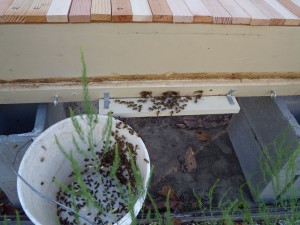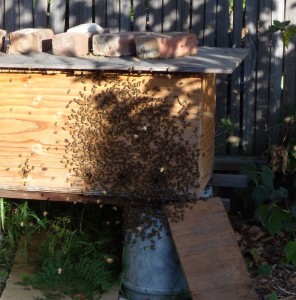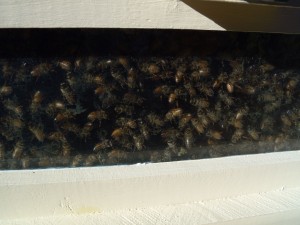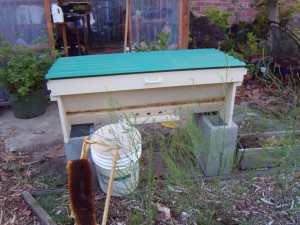Since the top-bar hive, Mondo, swarmed at the end of April, we’ve been waiting expectantly for secondary swarms. I even made a practice of suiting up and wriggling under the hive at night to listen for virgin queens piping (we were lucky enough to hear them last year!).
No luck hearing the queen piping, but today the bees swarmed late morning and settled high in the swarm catching camphor tree. Since Kelly is on couch rest following knee surgery, I called up our extremely kind, generous, and capable beekeeping friend Debi for reinforcement. She dropped everything and headed over.
The swarm had settled near the end of a branch, and we were just able to position the extension ladder within reach. I tied the top of the ladder to the branch to be on the safe side and, leaning far out with a five gallon bucket in my left hand, I reached the dangling mass of bees and gently knocked them off into the bucket. Normally, I would have preferred to give the branch a good shake to make the bees drop into the bucket, but this approach wasn’t feasible given my ladder positioning and the size of the branch.
With bucket of bees in hand, I hightailed it down the ladder, speed-walked across the garden, and dumped the bees into our waiting top-bar hive (a fabulous contraption fitted with an observation window and crafted by another beekeeping friend). A few more trips up the ladder to knock down bees that were reassembling on the branch, and Debi and I deemed the operation a success.
We were fairly certain that we had the queen safely hived, because when we placed a bucket of bees outside the top-bar, they immediately filed inside.
Moments later, though, Debi pointed to Mondo’s front, where hundreds of bees now milled about. Were they coming, or going? Crouching beside the hive, I smelled the lemony scent of bees communicating about a queen. Within 20 minutes, they had entered the hive, and the spectacle was over. Debi astutely suggested that the bees remaining on the tree branch must have realized they had lost their queen and returned to the hive from which their swarm had issued.
As of dusk, the bee yard is quiet. A few bees are coming and going from the new top-bar and, peeking in the observation window, I can see a mass of bees hanging along the back of the hive. They are in one clump and haven’t separated into the multiple clumps we associate with Mondo’s multi-queen swarms. If this secondary swarm really has only one queen, it marks the first time that we have seen Mondo’s lineage limit itself to swarming with just one queen. We were starting to think that multi-queen swarms must be a dominant genetic trait.
Mondo herself appears quiet, as does the primary swarm we hived last week. As a side note, I inspected that new hive yesterday and found several frames of uncapped brood and eggs already laid. This confirms our suspicion that the swarm is a primary one, issuing with the mated queen that overwintered in the hive. We are excited to follow her journey and see if she survives another winter.
As for our newly populated top-bar hive, we’ve named the colony T.R., after the neighbor who kindly phoned to inform us that our bees were “swarming everywhere in the backyard!” Here’s hoping they stay put.







